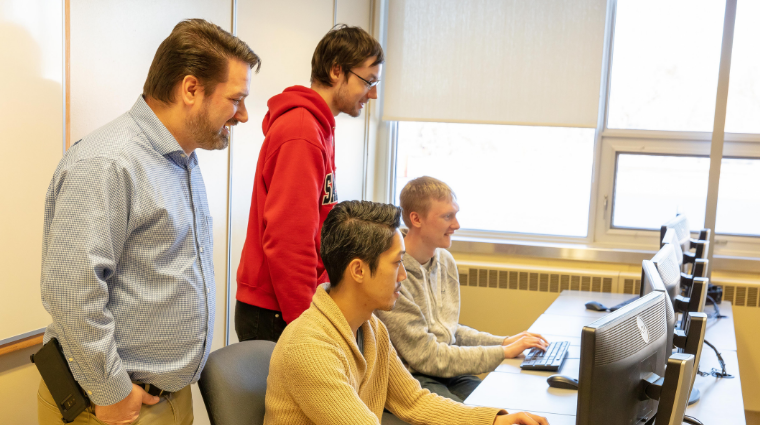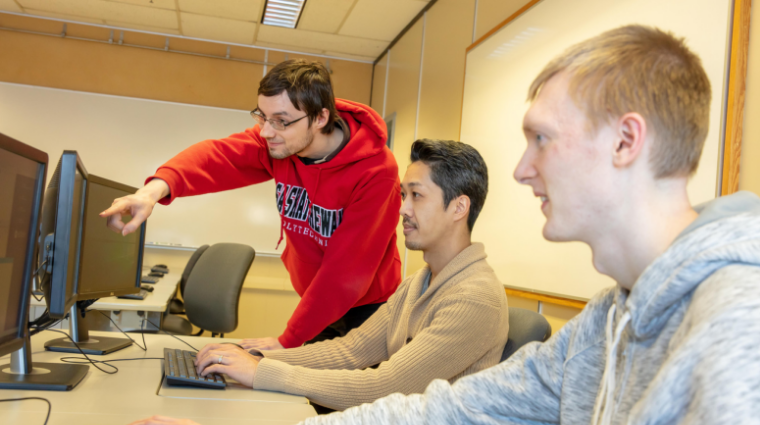
Pilot project advances applied research for industry partners
Five Saskatchewan Polytechnic students are tackling bullying and creating augmented reality systems with innovative new applications they’ve developed through applied research projects.
The students, enrolled in the Computer Systems Technology diploma program, are the first polytechnic recipients of Mitacs funding in Canada, thanks to a new pilot project recently opened to Canadian colleges and polytechnics. Mitacs is a national, not-for-profit organization that has designed and delivered research and training programs in Canada for 19 years. Working with polytechnics, colleges, universities, 4,000 companies, and both federal and provincial governments, Mitacs builds partnerships that support industrial and social innovation by funding student research internships.
“This was a trial to find out how well polytechnics and colleges could take advantage of this program, and the results turned out to be a win-win for both the students and their industry partners” says Dr. Terry Peckham, research chair with the Digital Integration Centre of Excellence.
Students Chris Nguyen, Draden Sawkey and Rafael De Luna partnered with the Restorative Action Program (RAP), a non-profit group that works with Saskatoon’s public and Catholic high school divisions. RAP provides local high schools with facilitators who offer students counselling, conflict resolution and leadership skills training.
Peckham says RAP needed a new system to measure the effectiveness of their program. “Until our students became involved all RAP could do was use anecdotal evidence, so we’ve started the process of building a system to track and quantifying some of those results.” He adds that no one in the field has addressed this challenge. As a result, “within a few years they will probably become the leading research base for this type of interaction with high school students throughout the world.”
“We were very impressed with the entire process,” says Winston Blake, RAP’s executive director. He says RAP originally approached Sask Polytech with the idea of digitizing their current system, but the students explained why a complete overhaul with real-time, quantifiable data would better serve their needs. “The students were able to educate us about how technology can work within the context of our program,” says Blake. “They helped us understand the availability of current technology to actually meet our needs.”
The other Mitacs grant supported a partnership project with Glacier FarmMedia (GFM). The students, Corey Janzen, Luke MacNeil and Rafael De Luna, were tasked with creating an augmented reality application for GFM’s Ag in Motion outdoor farm expo, held annually near Langham. With a three-day show that has over 450 exhibitors and 30,000 visitors, Ag in Motion had a very specialized need for a custom app.
By downloading the app onto their cellphones, expo attendees gained access to wayfinding information, event details and schedules, bonus information about crop varieties, the inner workings of farm machinery and much more. In return, GFM’s exhibitors (and GFM themselves) gained crucial insight into the attendees’ interests and behaviour, such as how many attendees walked by each booth, how many stopped and for how long. “There are all sorts of wonderful types of tracking information that the exhibitors get, and Ag in Motion needs,” says Peckham.
Ag in Motion plans to continue development of the app, with enhancements coming forward each year.
The impact of these applied research internships is mutually beneficial for students and industry partners. Industry partners gain access to cutting-edge technologies that lead to measurable outcomes, while the students gain knowledge that is very difficult to obtain in a classroom setting.
“The skill sets the students learn are incredibly valuable,” says Peckham. “Our students were able to impress the clients enough that they’re coming back for more work, and the companies get to move their applied research projects forward that they weren’t able to move forward before.”


